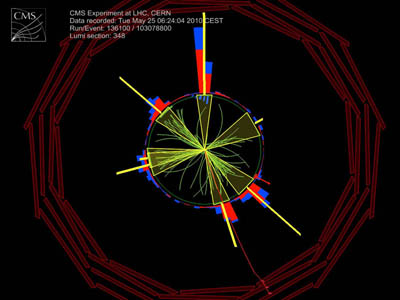This track is an example of simulated data of a decay path of the Higgs boson that may be observed at the LHC when it started taking data in 2008. The Higgs boson is produced in the collision of two protons and quickly decays into four muons. Image: CERN
CERN physicists have today revealed they may have experienced ‘tantalising hints’ of the Higgs boson, and that they are close to solving the riddle that has been puzzling the particle physics community and which could revolutionise the scientific field, paving the way for a new physics.
However, the physicists said today they cannot yet make any conclusive statement on the existence or non-existence of the elusive Higgs, but said the conundrum surrounding the existence of Higgs boson will be resolved later in 2012.
The scientists were speaking at today’s CERN conference, during which they presented the status of their findings for the Standard Model Higgs boson.
Some experts in the physics world, such as theoretical physicist and cosmologist Prof Stephen Hawking, believe the Higgs boson does not exist.
The scientists at CERN said today their results are based on the analysis of considerably more data than those presented at the summer conferences, sufficient to make significant progress in the search for the Higgs boson, but not enough to make any conclusive statement on the existence or non-existence of the Higgs.
Their main conclusion is that the Standard Model Higgs boson, if it exists, is most likely to have a mass constrained to the range 116-130 GeV by the ATLAS experiment, and 115-127 GeV by CMS.
They said “tantalising hints have been seen by both experiments in this mass region, but these are not yet strong enough to claim a discovery”.

CMS experiment on particles at the Large Hadron Collider (LHC) at CERN
Studying Higgs bosons
Higgs bosons, if they exist, are very short lived and can decay in many different ways. Discovery relies on observing the particles they decay into rather than the Higgs itself, said the physicists working on the projects.
Both ATLAS and CMS have analysed several decay channels, and the experiments see small excesses in the low mass region that has not yet been excluded, they said.
Taken individually, none of these excesses is any more statistically significant than rolling a die and coming up with two sixes in a row. What is interesting, said the scientists, is that there are multiple independent measurements pointing to the region of 124 to 126 GeV.
“It’s far too early to say whether ATLAS and CMS have discovered the Higgs boson, but these updated results are generating a lot of interest in the particle physics community. We have restricted the most likely mass region for the Higgs boson to 116-130 GeV, and over the last few weeks we have started to see an intriguing excess of events in the mass range around 125 GeV,” explained ATLAS experiment spokesperson Fabiola Gianotti.
“This excess may be due to a fluctuation, but it could also be something more interesting. We cannot conclude anything at this stage. We need more study and more data. Given the outstanding performance of the LHC this year, we will not need to wait long for enough data and can look forward to resolving this puzzle in 2012,” added Gianotti.
“We cannot exclude the presence of the Standard Model Higgs between 115 and 127 GeV because of a modest excess of events in this mass region that appears, quite consistently, in five independent channels,” explained CMS experiment spokesperson, Guido Tonelli.
“The excess is most compatible with a Standard Model Higgs in the vicinity of 124 GeV and below but the statistical significance is not large enough to say anything conclusive. As of today, what we see is consistent either with a background fluctuation or with the presence of the boson. Refined analyses and additional data delivered in 2012 by this magnificent machine will definitely give an answer.”

Large Hadron Collider (LHC) at CERN. The LHC gigantic scientific instrument spans the border between Switzerland and France about 100m underground. It is a particle accelerator used by physicists to study the smallest-known particles, with the aim of revolutionising our understanding of the universe’s vastness
Future experiments
Over the coming months, both the Atlas and CMS experiments will be further refining their analyses in time for the winter particle physics conferences in March. However, a definitive statement on the existence or non-existence of the Higgs will require more data, and is not likely until later in 2012.
The Standard Model is the theory that physicists use to describe the behaviour of fundamental particles and the forces that act between them. It describes the ordinary matter from which we, and everything visible in the universe, are made extremely well. Nevertheless, the Standard Model does not describe the 96pc of the universe that is invisible. One of the main goals of the LHC research programme is to go beyond the Standard Model, and the Higgs boson could be the key, said CERN today.
A Standard Model Higgs boson would confirm a theory first put forward in the 1960s, but there are other possible forms the Higgs boson could take, linked to theories that go beyond the Standard Model, said a CERN spokesperson today.
The scientists said Standard Model Higgs could still point the way to new physics, through subtleties in its behaviour would only emerge after studying a large number of Higgs particle decays.
“A non-Standard Model Higgs, currently beyond the reach of the LHC experiments with data so far recorded, would immediately open the door to new physics, whereas the absence of a Standard Model Higgs would point strongly to new physics at the LHC’s full design energy, set to be achieved after 2014. Whether ATLAS and CMS show over the coming months that the Standard Model Higgs boson exists or not, the LHC programme is opening the way to new physics,” said CERN officials today.